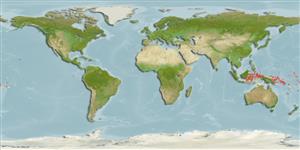>
Eupercaria/misc (Various families in series Eupercaria) >
Lutjanidae (Snappers) > Lutjaninae
Etymology: Lutjanus: Malay, ikan lutjan, name of a fish.
Environment: milieu / climate zone / depth range / distribution range
Ökologie
seewasser riff-verbunden; tiefenbereich 10 - 150 m (Ref. 55), usually 10 - 20 m (Ref. 90102). Tropical; 5°N - 16°S, 115°E - 166°W (Ref. 55)
Western Pacific: known only from Samoa and Indonesia (Sulawesi).
Size / Gewicht / Alter
Maturity: Lm ? range ? - ? cm
Max length : 32.0 cm TL Männchen/unbestimmt; (Ref. 48635)
Rückenflossenstacheln (insgesamt): 10; Rückenflossenweichstrahlen (insgesamt): 13; Afterflossenstacheln 3; Afterflossenweichstrahlen: 8. Appears bright yellow underwater (Ref. 48635). Dorsal profile of head gently sloped. Preorbital bone narrower than eye diameter. Preopercular notch and knob poorly developed. Scale rows on back rising obliquely above lateral line. Back and sides reddish, grading to pink; the ventral portion of the head and body white; a series of faint, yellow horizontal lines on the sides; fins whitish or yellow. Juveniles are relatively slender and similar in shape to L. vitta (Ref. 48635).
Adults inhabit offshore reefs. Also deep coastal muddy reef slopes with reef outcrops and often on shipwrecks in depth over 20 m. Seen singly or in small aggregations (Ref. 48635). Occasionally seen at depths of 10-20 m (Ref. 90102).
Life cycle and mating behavior
Geschlechtsreife | Fortpflanzung | Ablaichen | Eier | Fecundity | Larven
Allen, G.R., 1985. FAO Species Catalogue. Vol. 6. Snappers of the world. An annotated and illustrated catalogue of lutjanid species known to date. FAO Fish. Synop. 125(6):208 p. Rome: FAO. (Ref. 55)
IUCN Rote Liste Status (Ref. 130435)
Bedrohung für Menschen
Harmless
Nutzung durch Menschen
Fischereien: weniger kommerziell
Mehr Information
NamenSynonymeMetabolismusRäuberÖkotoxikologieFortpflanzungGeschlechtsreifeAblaichenSpawning aggregationFecundityEierEientwicklung
ReferenzenAquakulturAquakultur ProfilZuchtlinienGenetikElectrophoresesVererbbarkeitKrankheitenVerarbeitungNutrientsMass conversion
PartnerBilderStamps, Coins Misc.LauteCiguateraGeschwindigkeitSchwimmstilKiemenoberflächeOtolithsGehirngrößeSehfähigkeit
Tools
Zusatzinformationen
Download XML
Internet Quellen
Estimates based on models
Preferred temperature (Ref.
123201): 28.1 - 29.1, mean 28.8 °C (based on 34 cells).
Phylogenetic diversity index (Ref.
82804): PD
50 = 0.5000 [Uniqueness, from 0.5 = low to 2.0 = high].
Bayesian length-weight: a=0.01479 (0.00706 - 0.03101), b=2.97 (2.81 - 3.13), in cm total length, based on LWR estimates for this Genus-body shape (Ref.
93245).
Trophic level (Ref.
69278): 3.8 ±0.6 se; based on size and trophs of closest relatives
Widerstandsfähigkeit (Ref.
120179): mittel, Verdopplung der Population dauert 1,4 - 4,4 Jahre. (Preliminary K or Fecundity.).
Fishing Vulnerability (Ref.
59153): Low vulnerability (22 of 100).
